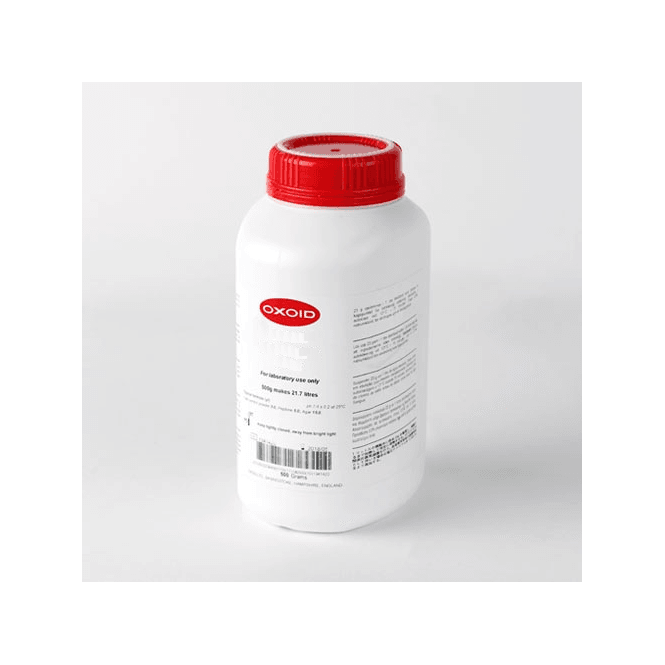Thermo Scientific™ Oxoid™ K-F Streptococcus Agar, 500G
Catalog No :
CAS Number :
Brand :
In Stock
Specifications:
| Application | Microbiology | ||
| Storage Temperature | Ambient | ||
| Product Type | Culture Medium | Forms | Powder |
| Product Brand | Thermo Fisher Scientific™, Oxoid | Target Organism Class | Enterococcus fecalis, Enterococcus subsp. liquefaciens, Enterococcus fecalis subsp. zymogenes, Enterococcus faecium, Enterococcus bovis, Enterococcus equinus, Streptococcus avium |
| Product Grade | Microbiology grade | ||
The Thermo Scientific™ Oxoid™ K-F Streptococcus Agar (Dehydrated) is a selective medium designed for the isolation and enumeration of enterococci in food, milk, water, and environmental samples. Based on the formula by Kenner et al., this medium supports the detection of Group D and Group Q enterococci, serving as an indicator of fecal contamination in various samples. The medium is suitable for use with pour-plate or membrane filtration methods.
Key Features
- Selective for Enterococci:
- Specifically targets Group D (e.g., Enterococcus faecalis) and Group Q (e.g., Streptococcus avium) species.
- Broad Application:
- Effective for testing food, dairy, water, and environmental samples for enterococci contamination.
- Fecal Pollution Indicator:
- Helps identify sources of fecal contamination (e.g., human, animal, or industrial) based on enterococcal species detected.
- Highly Differentiating:
- Colonies of enterococci appear red or pink, making them easy to identify and count.
- Compliant with Standards:
- Meets guidelines outlined by the USDA and APHA for water and environmental testing.
Applications
1. Food Microbiology
- Detection of enterococci in milk, meat, and dairy products to ensure food safety.
- Monitoring contamination in meat processing plants and dairy production facilities.
2. Water and Environmental Microbiology
- Enumeration of enterococci in potable water, recreational waters, and wastewater.
- Assessing pollution levels in environmental samples such as soil, farm runoff, and industrial waste.
3. Public Health and Research
- Identifying potential contamination sources and distinguishing between human and animal fecal pollution.
Specifications
| Attribute | Details |
|---|---|
| Product Type | Agar |
| Form | Powder |
| Description | K-F Streptococcus Agar Base |
| Applications | Food, water, and environmental microbiology |
| Quantity | 500g |
| Yield | 6.5L of prepared medium |
Preparation Instructions
- Suspend: Suspend 76g of K-F Streptococcus Agar powder in 1 liter of distilled water.
- Mix and Heat: Heat with frequent agitation until fully dissolved.
- Sterilize: Autoclave at 121°C for 15 minutes.
- Cool and Dispense: Pour the medium into sterile Petri dishes or use with membrane filtration as required.
Advantages
- Reliable Detection: Distinguishes enterococcal species with red or pink colonies for easy identification.
- Comprehensive Testing: Suitable for diverse sample types, including food, water, and environmental matrices.
- Source-Specific Pollution Identification: Differentiates human versus animal fecal contamination.
- Standardized Performance: Meets USDA and APHA requirements for microbiological testing.
- Cost-Effective: High yield of 6.5L per 500g, ideal for routine and high-throughput testing.
Diagnostic Features
| Organism | Reaction |
|---|---|
| Enterococcus faecalis (Group D) | Red or pink colonies (0.3–2mm diameter) |
| Enterococcus equinus (Group D) | Red or pink colonies |
| Streptococcus avium (Group Q) | Red or pink colonies |
| Non-Enterococci | Growth suppressed |
Storage and Stability
- Storage: Store the dehydrated medium at 10–30°C in a dry environment.
- Shelf Life: Refer to product label for expiration date.
Packaging
- Product: K-F Streptococcus Agar (Dehydrated)
- Catalog Number: CM0701B
- Quantity: 500g
- Yield: 6.5L of prepared medium
The Thermo Scientific™ Oxoid™ K-F Streptococcus Agar (Dehydrated) is a selective and reliable medium for detecting and enumerating enterococci in food, water, and environmental samples. Its ability to provide source-specific information about fecal contamination makes it an essential tool for public health, environmental monitoring, and food safety laboratories. Its compliance with USDA and APHA standards ensures accurate and reliable performance.




 0
0
